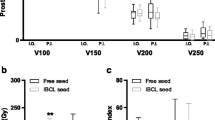Purpose:
To determine whether dose distribution achieved with treatment plans using high- and low-activity 125I implants differs.
Patients and Methods: Based on intraoperative transrectal ultrasound scans of 71 patients, inverse automated treatment plans (IATP) were performed with 15.5-kBq (0.42-mCi) and 25.2-kBq (0.68-mCi) 125I implants using a commercial 3-D planning system (Variseed®). A prescription dose of 145 Gy in 98% of the prostate volume (V100), a maximum dose to the urethra of 250 Gy (D1), and a maximum dose to 10% of the anterior rectal wall of 145 Gy (D10) were required. The plans were manually corrected, if necessary.
Results: In the IATP, a better dose coverage of the prostate was found for high-activity seeds (V100 of 98% vs 84%). The prostate dose values increased with the prostate volume. After manual optimization, the differences were only marginal with a prostate V100 of 99% for both activities, a urethra D1 of 247 Gy and 239 Gy, and a rectum D10 of 135 Gy and 124 Gy for high- and low-activity seeds. Low-activity seeds required more sources (66 vs 47) and needles (24 vs 17; all numbers are median values).
Conclusions: Concerning the prostate dose coverage, high-activity seeds are superior in the IATP. After manual adjustment, the dose values for the prostate and the organs at risk are similar. Considering a supposedly decreased toxicity and a shorter implantation time for a lower number of seeds, we recommend high-activity seeds for experienced teams.
Fragestellung:
Erzielt die Bestrahlungsplanung sowohl mit hoch- als auch mit niedrigaktiven 125J-Seeds eine optimale Dosisverteilung?
Patienten und Methodik: Basierend auf intraoperativen transrektalen Ultraschallbildern von 71 Patienten erfolgte eine inverse automatische Bestrahlungsplanung (IATP) unter Verwendung von 15,5-kBq-(0,42-mCi-) und 25,2-kBq-(0,68-mCi-)-125J-Seeds mit einem kommerziellen 3-D-Planungssystem (Variseed®). Eine Verschreibungsdosis von 145 Gy in 98% des Prostatavolumens (V100), eine maximale Dosis im Bereich der Urethra von 250 Gy (D1) und maximal 10% der Rektumvorderwand im Bereich der 145-Gy-Isodose (D10) wurden gefordert. Die Pläne wurden bei Notwendigkeit manuell verbessert.
Ergebnisse: Im IATP wurde eine bessere Dosis für die Prostata bei hochaktiven Seeds erreicht (V100 von 98% vs. 84%). Die Dosiswerte für die Prostata stiegen mit zunehmendem Prostatavolumen. Nach manueller Optimierung waren die Unterschiede nur marginal (Prostata V100 von 99% für beide Aktivitäten, Urethra D1 von 247 Gy und 239 Gy und Rektum D10 von 135 Gy und 124 Gy für hohe und niedrige Aktivitäten). Bei Anwendung der niedrigen Aktivität wurden mehr Seeds (66 vs. 47) und Nadeln (24 vs. 17) benötigt (alle Zahlen sind Medianwerte).
Schlussfolgerungen: Unter Verwendung der IATP zeigen sich die hochaktiven Seeds bezüglich der Prostatadosis überlegen. Nach manueller Korrektur sind die Dosiswerte für die Prostata und die Risikoorgane ähnlich. Berücksichtigt man die anzunehmende geringere Toxizität und kürzere Implantationsdauer für eine kleinere Anzahl von Seeds, so sind hochaktive Seeds für erfahrene Teams zu empfehlen.
Similar content being viewed by others
Author information
Authors and Affiliations
Additional information
Received: May 8, 2002; accepted: September 9, 2002
Address for Correspondence Dr. Michael Pinkawa, Klinik für Strahlentherapie, Universitätsklinikum der RWTH Aachen, Pauwelsstraße 30, 52057 Aachen, Germany, Phone (+49/241) 80-88777, Fax -425, e-mail: Michael.Pinkawa@post.rwth-aachen.de
Rights and permissions
About this article
Cite this article
Pinkawa, M., Maurer, U., Mulhern, A. et al. Inverse Automated Treatment Planning with and without Individual Optimization in Interstitial Permanent Prostate Brachytherapy with High- and Low-Activity 125I. Strahlenther Onkol 179, 417–422 (2003). https://doi.org/10.1007/s00066-003-1042-z
Issue Date:
DOI: https://doi.org/10.1007/s00066-003-1042-z




